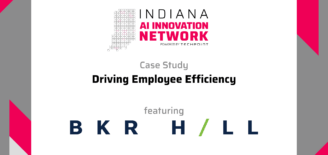Making permanent improvements to the tech worker pipeline
Apprenticeships are not a new idea, but they are a big part of a new talent plan whose time has come for Indiana’s tech community. In order to remain relevant as a national tech hub, Indiana must inclusively hire 41,000 people for tech jobs by 2030.
Hiring high-potential individuals and providing training for jobs currently unfilled or under-filled is the most efficient and effective way to achieve this ambitious objective. Employers everywhere face an uphill battle filling open positions, attracting quality candidates, and retaining them as employees. Apprenticeships offer a timely solution for securing diverse and skilled tech talent, as well as providing unique benefits for employers nationwide.
Moving away from degree-based hiring
In order to adequately convey the value of apprenticeships, it is critical to understand the need for skills-based hiring as an alternative to degree-based hiring. According to a Monster Intelligence 2022 report, 87 percent of surveyed employers reported difficulty in finding qualified talent as a result of the skills gap, which denotes the void between skills needed for a position and the skills available.
According to Harvard Business School’s project on Managing the Future of Work, the skills gap is, in part, due to reliance on automation and hiring that heavily focuses on trying to find the “perfect” candidate. Part of this perfect candidate algorithm is a four-year degree. This automated way of hiring leaves out many qualified and skilled workers who would ultimately help solve the skills gap. Harvard’s report refers to these workers as “hidden” workers, and suggests that hiring hidden talent could be the solution to talent shortages.
Harvard Business School recently surveyed more than 8,000 hidden workers and 2,250 executives across the U.S., the U.K. and Germany as part of a global study. They discovered that “companies that purposefully hire hidden workers realize an attractive return on investment (ROI). They report being 36 percent less likely to face talent and skills shortages compared to companies that do not hire hidden workers. And they indicate former hidden workers outperform their peers materially on six key evaluative criteria—attitude and work ethic, productivity, quality of work, engagement, attendance, and innovation.”
Apprenticeship: Key Benefits for Employers
Today’s economic landscape can prove challenging for employers seeking to recruit, hire and retain skilled talent. Apprenticeship offers solutions to several challenges facing employers today.
Improvement in finding and attracting quality candidates
As previously mentioned, it’s not that there are not enough qualified candidates, but that they are not easily found with current hiring practices. There are many skilled candidates who wish for companies to simply give them a chance while working to strategize the content in their resumes to fit some unknown algorithm so that they can be seen by the right people. Yet, these are qualified candidates who are often overlooked.
Apprenticeship offers a better model for attracting, hiring, and retaining these quality candidates by helping employers build a custom talent pipeline that ultimately helps to grow their business.
Higher employee retention
Turnover is not only inconvenient, it is a big blow to a company’s bottom line. Apprenticeships result in higher retention rates when compared to traditional, degree-based hiring models. One reason apprenticeships are successful in retaining skilled candidates is because they match the skills and abilities of the apprentice to the specific business needs of the employer. This creates a win-win situation for all involved.
Apprentices are given the opportunity to use the skills they have now while also learning new skills through the apprenticeship program. Employers are able to strategically align their business goals with the skills development of the apprentice. This is a proven model for retaining skilled workers and it has been working in other industries for many years.
The U.S. Department of Labor’s performance outcomes indicate that 91 percent of registered apprentices who complete the program retain employment. According to ApprenticeshipUSA, 93 percent of apprentices stay with their employer after they complete the program.
Increased employee diversity
Tech companies of all sizes are becoming increasingly compelled to evaluate and address diversity. When it comes to minority representation, Indiana’s tech workforce falls behind the Indiana workforce as a whole. As a skills-based hiring model, apprenticeships naturally open doors to a broader candidate pool. For example, 81percent of NEW’s apprentices are underrepresented groups in tech.
This diverse representation is simply achieved by opening doors to overlooked populations. With no-cost to the apprentice model, New Apprenticeship’s programs enable a highly diverse workforce to complete the training they need to succeed in tech without incurring debt. This approach eliminates a common barrier for minority groups to break into tech professions.
Creating a sustainable tech talent pipeline
It goes without saying that it’s not enough to build a talent pipeline. Prior to building the talent pipeline, employers must focus and plan how to sustain it. Even though there are cases for hiring freelance workers and contractors, building a talent pipeline is a better long-term solution to closing the skills gap. Studies have shown that a vast majority of skilled workers tend to leave when they feel that they have maxed out their skill development with a company.
In contrast to traditional degree-based hiring models, the apprenticeship model nurtures and helps grow hidden talent by offering continued education and skills development that is catered to the needs of the employer. The outdated model of hiring based solely on a four year degree lends itself to higher potential for low employee engagement, burnout, and low retention rates. By hiring skilled people who learn and grow with the company, innovation improves, soft skills are developed, and loyalty to the company is increased.
Loosening the grip on outdated hiring models
According to a recent ZD NET article, 47 percent of tech employers believe that focusing on skills first is the best approach to hiring. A mere 26 percent believe that college degrees are impactful. However, a staggering percentage (81 percent) of tech employers still heavily require a college degree today.
Shifting to a skills-first hiring practice is not breaking news. LinkedIn, as well as Indeed, Monster, and other notable companies, have been discussing this shift since 2010. Skills-first hiring is already being implemented by top tech companies in the U.S. and abroad. This is the future of work in Indiana and the rest of the world as well.
By loosening the grip on outdated models of hiring and implementing this innovative solution, employers in Indiana will be equipped to shift with the rest of the world, grow their talent pipeline, and retain a more diverse, qualified, and engaged workforce.
Learn how initiatives like apprenticeships play into the larger goal of adding 41,000 tech workers by the year 2030, which we’re calling Mission41K.
Read how Adult Apprenticeships have great potential to address talent concerns and strengthen our talent pipelines by providing equitable access to careers in tech.


